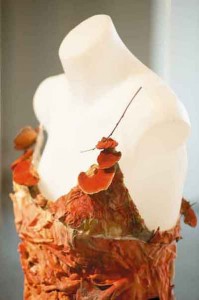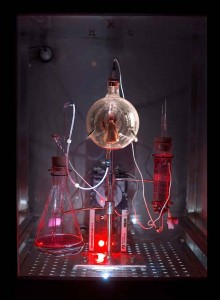Growing garments is a concept which is physically being explored by some artists who are using the processes of biological life as their palette. Living beings have been extensively used for the creation of cloths, however, they were always dead by the time they ended up on the body, and in most cases heavily processed. Why are humans the only animal who dress? Humans, the naked apes, have perfected the technique of hiding their bareness with an elaborate social/political/economical display.
There are a few theories that attempt to explain why humans became furless. The most popular theory argues that hairlessness evolved to control body temperature in the heat. We are descended from apes who moved out of the forests onto the open savannah. Another version advocates for the facilitation of sweat-cooling. But many species resort to sweat-cooling quite effectively without needing to lose their hair. Furthermore, hairless skin increases the rates of energy gain and loss during extreme periods.
The Aquatic Ape Theory (AAT) suggests that our earliest ancestors had lived for a prolonged period in a semi-aquatic habitat before moving onto the savannah. AAT points out that most of the “enigmatic” features of human physiology, though rare or even unique among land mammals, are common in aquatic ones. Another theory says the naked ape lost its fur in order to deprive fleas, ticks and other blood sucking insects: As human social groupings grew, and utters (read pre-language) replaced grooming as a tool for social bonding and hierarchy, there was a need for other strategies to deal with these parasites. In time, as Darwin suggested, hairlessness became a sexually attractive trait, ensuring that it was passed down through the generations. Whatever the reason we can examine garments as a form of ethnocentric technology which reflects our ever increasing separation from “nature” as well as our use (and exploitation) of other living systems for purposes that go far beyond basic survival.
As technology develops, there are growing attempts to make the covering of skin into a way of enhancing our biology, not just in terms of sexual selection (enhancers of attractiveness/fitness and social status). New “smart” materials are set to enhance physical and perceptual abilities of the wearers. Many of these new materials are described using biological and biomimetic metaphors. It is not surprising then that in the age of biotechnology there are attempts to use living biological processes to create new materials and garments – Biowear. This Biowear can be either living biological components embedded in “traditional” clothing, such as the attempt to develop miniature liver tissue bioreactors to identify toxins in the environment , or living/semi-living garments. An interesting point, however, is that in some cases these attempts of using living biological processes do not seem to enhance the body, but rather, compromise it.
The (re)introduction of an additional living layer was much discussed in science fiction – however, artists are suggesting and actualising ways in which garments could be grown, fermented and cultured using a variety of organisms and techniques. This second biological skin can be seen as a shift from the ways the new biology is being exploited – bringing into question traditional materials and notions of life as a raw material.
 Fungi: Donna Franklin created Fibre Reactive, in 2004; a living garment, grown from the fungi pycnoporous coccineus (orange bracket fungus). Donna explains ‘the piece aims to confront the viewer by the juxtaposition of something familiar, with something visceral and challenging. This occurs when the viewer is faced with the reality of the biological component. The dress becomes an entity of its own – it grows, lives and dies, it requires nutrients rather than washing and ironing – somewhere between a house plant and pet. By growing a living colour the garment changes from season to season, doing away with the need to endlessly consume clothes from summer to spring!’
Fungi: Donna Franklin created Fibre Reactive, in 2004; a living garment, grown from the fungi pycnoporous coccineus (orange bracket fungus). Donna explains ‘the piece aims to confront the viewer by the juxtaposition of something familiar, with something visceral and challenging. This occurs when the viewer is faced with the reality of the biological component. The dress becomes an entity of its own – it grows, lives and dies, it requires nutrients rather than washing and ironing – somewhere between a house plant and pet. By growing a living colour the garment changes from season to season, doing away with the need to endlessly consume clothes from summer to spring!’
Bacteria: In her BioCouture project, Suzanne Lee is using yeast and bacteria to grow fabric; “cultivating the material in a sweet tea-solution, a technique which has been in use for ages in the production of Kombucha. When exposed to such an environment, the bacteria produce a material which is in between papyrus and leather with a colour that can be altered through the choice of tea.” Lee explores issues of technological sustainability as part of this project and is now interested in a bacteria garment that will eat itself.
Animal/human tissue: The Tissue Culture & Art project (TC&A) was set up to explore the use of tissue technologies as a medium for the creation of objects of partial life and semi-living artistic entities. We use tissues obtained from animals to grow three dimensional living tissue structures. Victimless Leather is a proposition to focus our attention to the fact that wearing leather involves the use of other living systems.
By the use of cell lines (or by the use of biopsies from animals that can be healed) we cultured layers of tissues over biodegradable matrixes to grow a stitch-less and “victimless” leather like material. We have grown a miniature jacket that can only survive within a sterile techno-scientific body. Our intention is not to provide yet another consumer product but rather to raise questions about our exploitation of other living beings. We see our role as artists as one in which we are providing tangible examples of possible futures, and researching the potential effects of these new forms on our cultural perceptions of life.
This artistic grown garment confronts people with the moral implications of wearing parts of dead animals for protective and aesthetic reasons and further challenges notions of relationships with living systems- manipulated or otherwise. An actualized possibility of wearing ‘leather’ without directly killing an animal is offered as a starting point for cultural discussion. It is not our role to provide people with goods for their daily use. We would like our work to be seen in this cultural context, and not in a commercial context
Victimless Leather is part of TC&A’s long held engagement with the hypocrisies we have to employ to maintain our relations/dependence with/on the living and constructed environment. Technology seems to promise us (among many other things) an illusion of a victimless utopia. TC&A argue that this technologically meditated victimless utopia is but a transformation of explicit violence into a hidden implicit one on a much greater scale. As urban Western culture seems to find it hard to stomach images of real violence (as opposed to cinematic and constructed simulated violence) its obsession with ever growing consumption inevitably created increasing numbers of victims from the ecology to other animals and humans. There is a shift from “the red” in the teeth and claws of nature to a mediated nature. The victims are pushed farther away; they still exist, but are much more hidden.
Like the victimless leather jacket, locked in the techno-scientific body, so we are running the risk of locking ourselves in ever so sophisticated technological covering. The technology of cloths has developed to protect the naked ape from its environment: is it time to reconsider this premise? Is it time to divert this technology to protect the environment from the technologically oriented naked ape? But then again do we dare to wear a living/semi living garment that can be unpredictable and contagious?
Oron Catts is Artistic Director and co-founder of SymbioticA and co-founder of the Tissue Culture & Art Project. Oron is an artist, researcher and a curator who has exhibited, lectured and published nationally and internationally. Ionat Zurr is the academic coordinator of SymbioticA and co-founder of the Tissue Culture & Art Project. Ionat is an artist, researcher and curator who has exhibited, lectured and published nationally and internationally.
SymbioticA- The Art & Science Collaborative Research Laboratory is located in the School of Anatomy & Human Biology at the University of Western Australia.
Read More
http://www.symbiotica.uwa.edu.au/
http://www.tca.uwa.edu.au/
 This work is licensed under a Creative Commons Attribution-NonCommercial-ShareAlike 2.5 Australia.
This work is licensed under a Creative Commons Attribution-NonCommercial-ShareAlike 2.5 Australia.







